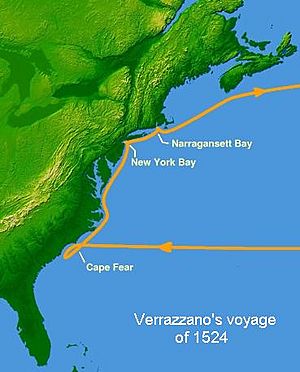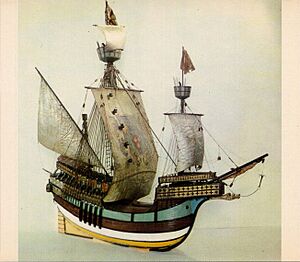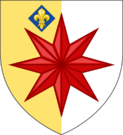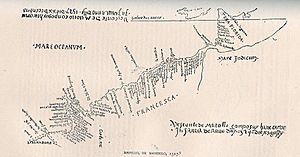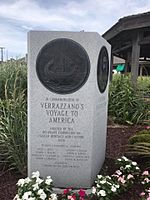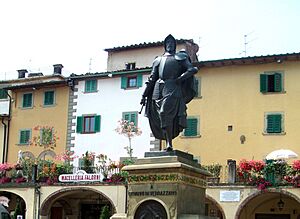Giovanni da Verrazzano facts for kids
Quick facts for kids
Giovanni da Verrazzano
|
|
|---|---|
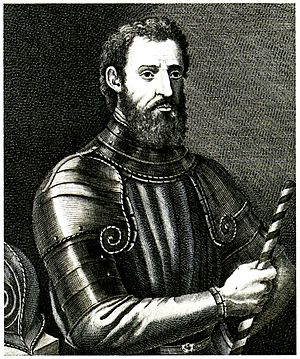 |
|
| Born | 1491 Val di Greve, Republic of Florence
(present-day Tuscany, Italy) |
| Died | 1528 (aged 42–43) |
| Nationality | Italian |
| Other names |
|
| Occupation | Explorer |
| Parents |
|
| Signature | |
Giovanni da Verrazzano (pronounced VERR-ə-ZAH-noh; born in 1491, died in 1528) was an Italian explorer from Florence. He is famous for his journey to North America. He led many missions for King Francis I of France, including his important trip to America.
Verrazzano was the first European to explore the Atlantic coast of North America. In 1524, he sailed along the coast from Florida to New Brunswick. This included discovering places like New York Bay and Narragansett Bay.
Contents
Early Life
Verrazzano was born in a place called Val di Greve, near Florence, Italy. Records show he was born on July 20, 1491. He always thought of himself as Florentine, and people at the time agreed.
When he was older, after 1506, he moved to Dieppe, a port city in France. There, he started his career as a navigator, which means he learned how to sail ships and find his way across the seas. He might have sailed to the American coast around 1508, possibly exploring Newfoundland. He also made many trips to the eastern Mediterranean Sea.
1522–24 Voyage to North America
In 1522, the remaining sailors from the Magellan expedition returned to Spain. They had sailed all the way around the world! This made countries like France eager to find new trade routes. In 1523, King Francis I of France asked Verrazzano to explore a part of North America. The king hoped Verrazzano could find a sea route to the Pacific Ocean, which would lead to China.
Florentine merchants in France helped pay for this expedition. They raised a lot of money, and Verrazzano also invested his own funds.
First, four ships set sail, but a big storm damaged two of them. The two remaining ships, La Dauphine and La Normande, had to go back to Brittany for repairs.
After fixing the ships, they tried again. This time, the ships headed south toward calmer waters. After a stop in Madeira, La Normande had to return home. But Verrazzano's ship, La Dauphine, continued its journey on January 17, 1524.
La Dauphine reached the area of Cape Fear, North Carolina, on March 21, 1524. After a short stop, they explored the Pamlico Sound lagoon. Verrazzano believed this large body of water was the beginning of the Pacific Ocean!
As they sailed further north, Verrazzano and his crew met Native Americans living along the coast. He sailed past the entrances to Chesapeake Bay and the mouth of the Delaware River without noticing them.
In New York Bay, he saw about 30 canoes of the Lenape people. He also saw what looked like a large lake, which was actually the entrance to the Hudson River. He then sailed along Long Island and into Narragansett Bay. Here, he met leaders from the Wampanoag and Narragansett people. He stayed there for two weeks before moving north.
He discovered Cape Cod Bay. He named a cape after a general, calling it Pallavicino. He then followed the coast all the way to modern-day Maine, southeastern Nova Scotia, and Newfoundland. He returned to France by July 8, 1524. Verrazzano named the land he explored Francesca to honor the French king. However, his brother's map later called it Nova Gallia, which means New France.
Later Life and Death
Verrazzano organized a second voyage in early 1527. He had financial help from Jean Ango and Philippe de Chabot. Four ships left France, but one got separated in a storm near the Cape Verde Islands. Verrazzano reached the coast of Brazil with two ships. They collected a valuable cargo of brazilwood before returning to France in September. The third ship also returned later with brazilwood.
This trip was a partial success, but it didn't find the Pacific Ocean route. This inspired Verrazzano's final voyage, which began in early 1528.
There are different stories about how Verrazzano died. One story says that during his third trip to North America in 1528, after exploring Florida, the Bahamas, and the Lesser Antilles, Verrazzano went ashore on an island, possibly Guadeloupe. He was reportedly attacked by the native people there, and his crew, anchored too far away, could not help him.
Some historians once thought Verrazzano was the same person as a pirate named Jean Fleury. However, historians have since shown that they were two different people.
Verrazzano's Lasting Impact
The information Verrazzano gathered on his voyage greatly helped mapmakers in the 1500s. However, his fame didn't spread as much as other explorers of his time. For example, he named the new land Francesca after the French king, but this name didn't stick. His amazing discoveries happened soon after other huge events, like the Spanish Conquest of the Aztec Empire and the first trip around the world.
For a long time, people in the United States debated if Verrazzano's letters about his journey were real. But after a special document called the Cèllere Codex was found in 1909, most people agreed his letters were true. A letter signed by King Francis I also mentioned Verrazzano's report, confirming its importance.
In New York City, people often remembered Henry Hudson's voyage in 1609 as the start of European exploration. Verrazzano's earlier trip in 1524 was largely forgotten. It took a lot of effort from the Italian-American community, especially in the 1900s, to make sure Verrazzano was recognized. This led to the naming of the famous Narrows Bridge after him.
Remembering Verrazzano
- In 1909, during the Hudson-Fulton Celebration, a bronze statue of Verrazzano by Ettore Ximenes was placed in Battery Park, Manhattan.
- Many things on Staten Island are named after him.
- The Verrazzano–Narrows Bridge, which connects Staten Island and Brooklyn, is the most famous. Until October 2018, it was known as the "Verrazano–Narrows Bridge" with one "z".
- A Staten Island Ferry boat that served New York from the 1950s to the 1990s was also named for Verrazzano.
- A Little League baseball team on Staten Island also carries his name.
- The Jamestown Verrazzano Bridge in Narragansett Bay, Rhode Island, is named for him, as is Maryland's Verrazano Bridge.
- An Italian navy ship, a destroyer of the Navigatori class class, was named after Verrazzano. It was launched in 1930 and sunk by a British submarine in 1942.
- There is a statue of him in his hometown of Greve in Chianti, Italy.
- A monument in Rehoboth Beach, Delaware, honors his voyage.
See also
 In Spanish: Giovanni da Verrazzano para niños
In Spanish: Giovanni da Verrazzano para niños


